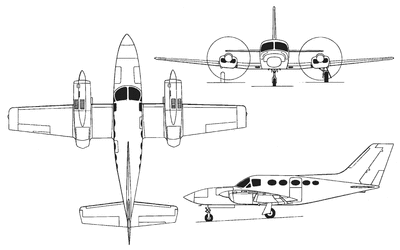One Person Fatally Injured When Cessna 421 Went Down
A Cessna 421 which went down August 27th in Paris, IL with one person on board had a history of issues with its left engine according to a preliminary report released late last week by the NTSB.

According to the prelim, the airplane went down at approximately 1120 central daylight time on August 27 in a wooded area shortly after takeoff from the Edgar County Airport (KPRG), Paris, IL. The airplane was destroyed by impact and post-impact fire. The airplane was registered to Venezia Marine, Inc., Terre Haute, Indiana, and operated by RSB Aviation, Inc, Paris, Illinois, under the provisions of 14 Code of Federal Regulations Part 91 as a positioning flight. VFR conditions prevailed for the flight, and a flight plan was not filed. The flight was originating at the time of the accident and was en route to the Terre Haute International Airport - Hulman Field (KHUF), Terre Haute, IN.
Prior to the flight, the pilot fueled the airplane with 178 gallons of fuel, which according to a company pilot, would have topped off the fuel tanks. The pilot intended to depart KPRG, pick up an individual at KHUF, and then continue the flight to Cincinnati, OH.
Witnesses observed the airplane during its takeoff roll from runway 09. They stated the airplane seemed to be very slow in comparison to other takeoff rolls they have observed with the accident airplane. Due to corn and other obstacles on airport property, the witnesses did not observe the airplane takeoff; however, shortly thereafter, they noticed a smoke plume about 1 mile east of the airport.
The accident site was located approximately 3/4 of a mile from the departure end of runway 09 (4,502 feet long by 75 feet wide). The airplane wreckage was distributed on a heading of 090 for approximately 300 feet. The airplane impacted numerous trees prior to coming to rest at the base of a large tree. A post-impact fire and 2 post-impact explosions ensued. Several separated sections of the left wing, left horizontal stabilizer, and left elevator were located near the initial tree impacts. The main wreckage consisted of the fuselage, right wing, a portion of the left wing, both engines, and portions of the empennage. The left engine propeller was found in the feathered position, and right engine propeller was found in an operating range position.

Visual examination and aerial photographs of the departure end of runway 09 and adjacent terrain showed the airplane's main landing gear exit the end of the runway surface, travel approximately 300 feet through grass, continue to travel approximately 300 feet through 3-foot-tall soybeans, and then impact the top of 10-foot-tall corn stalks for approximately 50 feet. Following the damaged corn stalks, there was no evidence of the airplane impacting terrain prior to the initial tree impacts.
The airplane was equipped with two Lycoming LTP 101-600A-1A turboprop engines. The Lycoming engines were originally installed on the airplane per a Supplemental Type Certificate in 1982. According to RSB Aviation company personnel, during the previous several weeks before the accident, the left engine had been experiencing a delay/lag in obtaining 100 percent power after engine start-up. After a period of time, typically about 30 seconds, the left engine would obtain 100 percent power. After the engine obtained 100 percent power, the engine would maintain the power unless the pilot commanded otherwise. The delay/lag would not occur at each engine start-up, but at intermittent times. The airplane was flown by RBS Aviation with the known delay/lag condition. According to maintenance personnel and another company pilot, the known problem with the left engine had not been corrected prior to the accident flight.
 ANN's Daily Aero-Term (04.25.24): Airport Rotating Beacon
ANN's Daily Aero-Term (04.25.24): Airport Rotating Beacon ANN's Daily Aero-Linx (04.25.24)
ANN's Daily Aero-Linx (04.25.24) Klyde Morris (04.22.24)
Klyde Morris (04.22.24) Airborne 04.24.24: INTEGRAL E, Elixir USA, M700 RVSM
Airborne 04.24.24: INTEGRAL E, Elixir USA, M700 RVSM Airborne 04.22.24: Rotor X Worsens, Airport Fees 4 FNB?, USMC Drone Pilot
Airborne 04.22.24: Rotor X Worsens, Airport Fees 4 FNB?, USMC Drone Pilot




